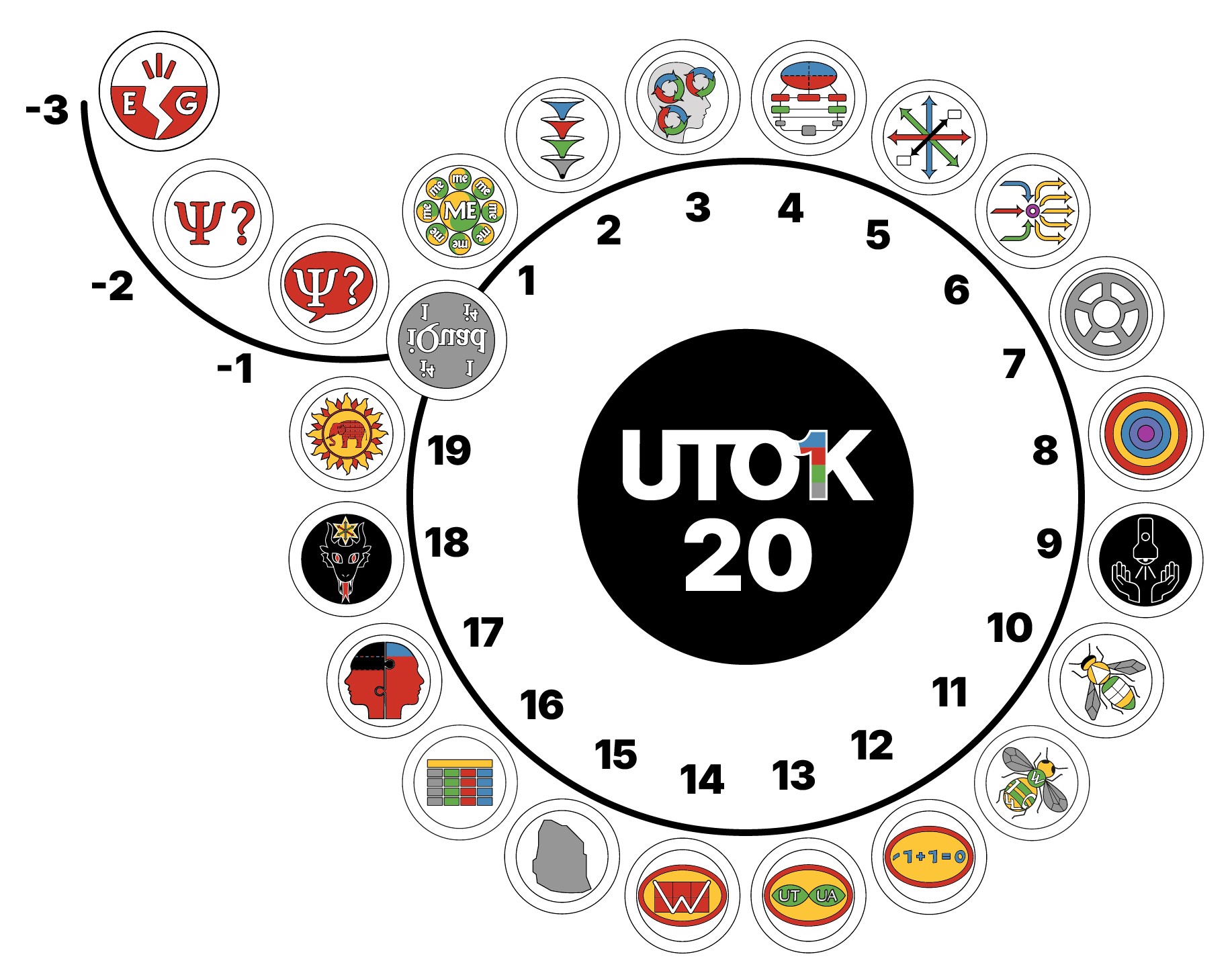


can be divided up into these 4 Groups
1) the four conceptual problems UTOK addresses;
2) the three philosophical pillars that provide UTOK’s epistemological frames;
3) UTOK’s metapsychology that unifies the science of psychology with the practice of psychotherapy; and
4) the UTOK 20, which is a map of the whole system.
Four Fundamental Problems
Four Fundamental Problems
Modern knowledge systems have failed to provide us with a clear philosophical picture that connects the natural sciences with the human psyche in a way that connects to the wisdom traditions. In contrast, UTOK succeeds in solving these problems and provides us the first, holistic, coherent worldview that unites natural science, human consciousness, and the nature of wise living into a single philosophical system.
Modern knowledge systems have failed to provide us with a clear philosophical picture that connects the natural sciences with the human psyche in a way that connects to the wisdom traditions. In contrast, UTOK succeeds in solving these problems and provides us the first, holistic, coherent worldview that unites natural science, human consciousness, and the nature of wise living into a single philosophical system.
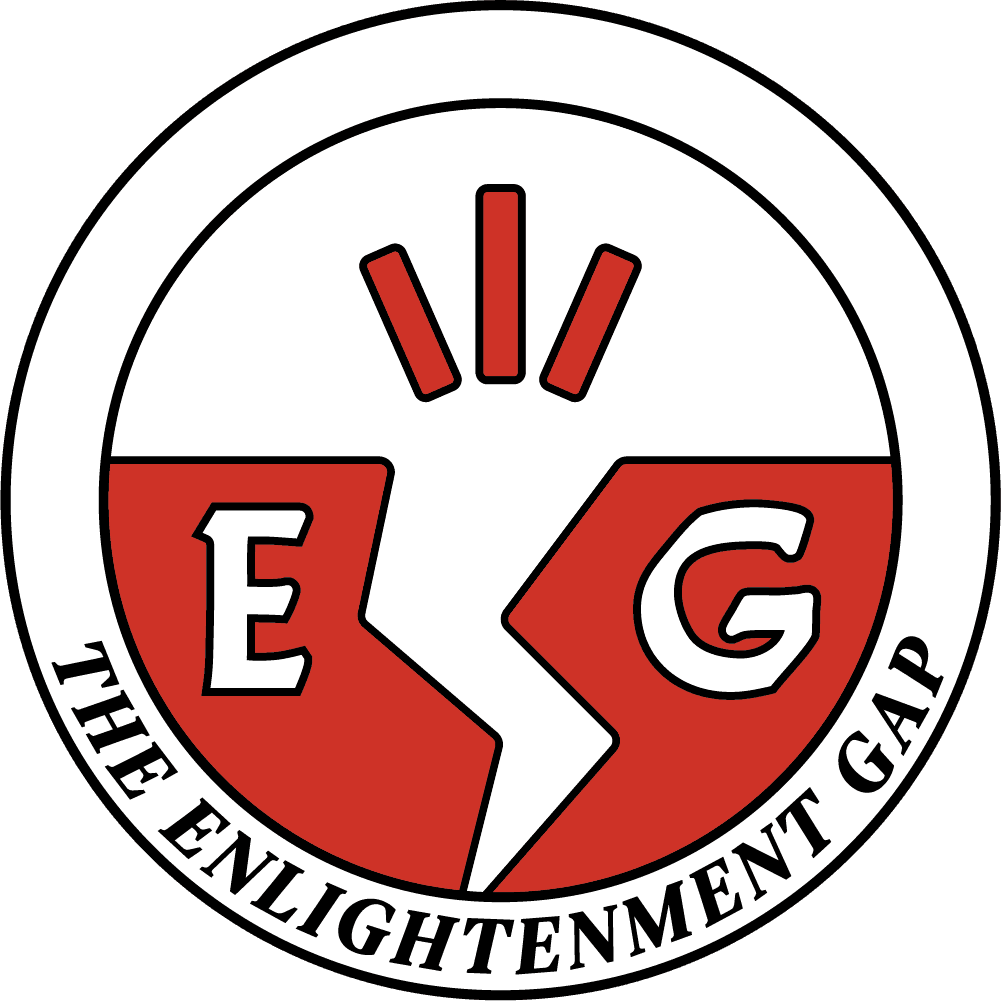

The Enlightenment Gap
Refers to the lack of a coherent worldview that effectively places mind in relationship to matter and integrates scientific knowledge with subjective and social knowledge. This overlaps with the (in)famous mind-body problem in modern philosophy.
Refers to the lack of a coherent worldview that effectively places mind in relationship to matter and integrates scientific knowledge with subjective and social knowledge. This overlaps with the (in)famous mind-body problem in modern philosophy.
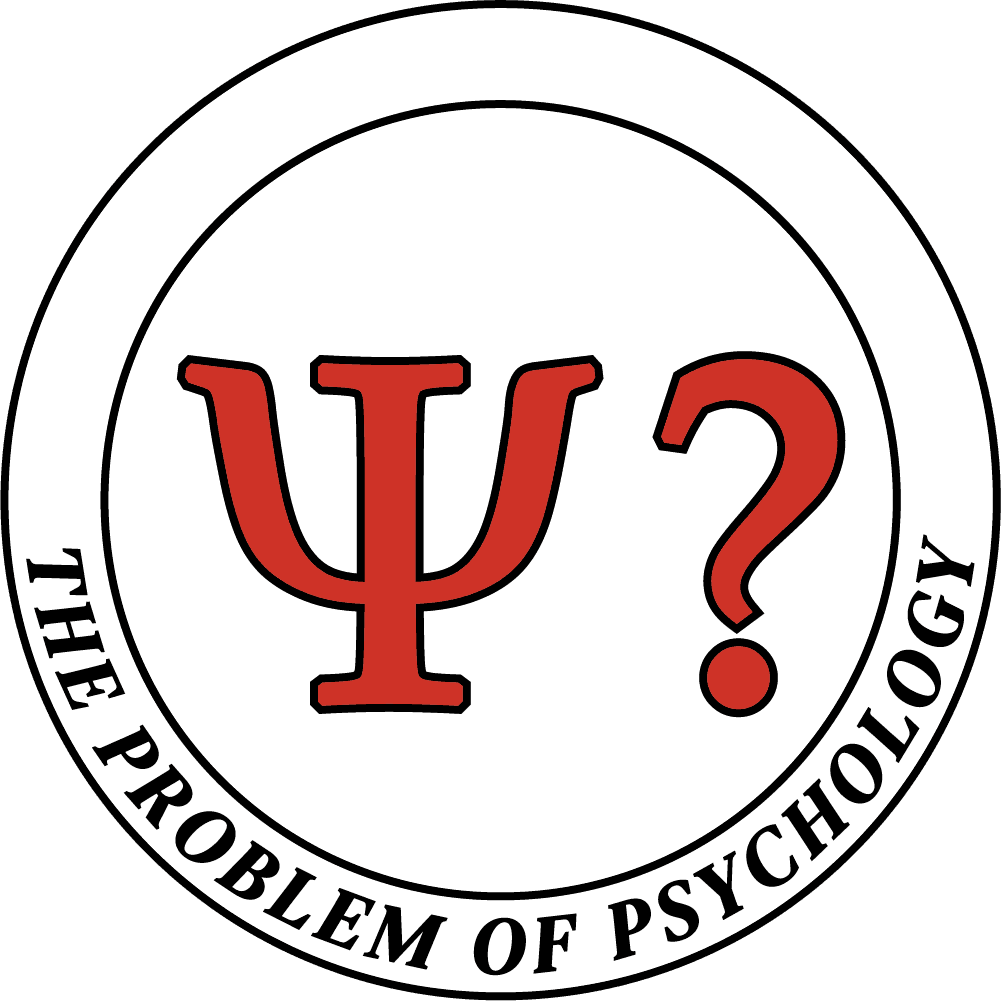
Problem of Psychology
Refers to the failure of psychological science to have a well-defined subject matter. It is historically referred to as the “crisis” of psychology.
Refers to the failure of psychological science to have a well-defined subject matter. It is historically referred to as the “crisis” of psychology.
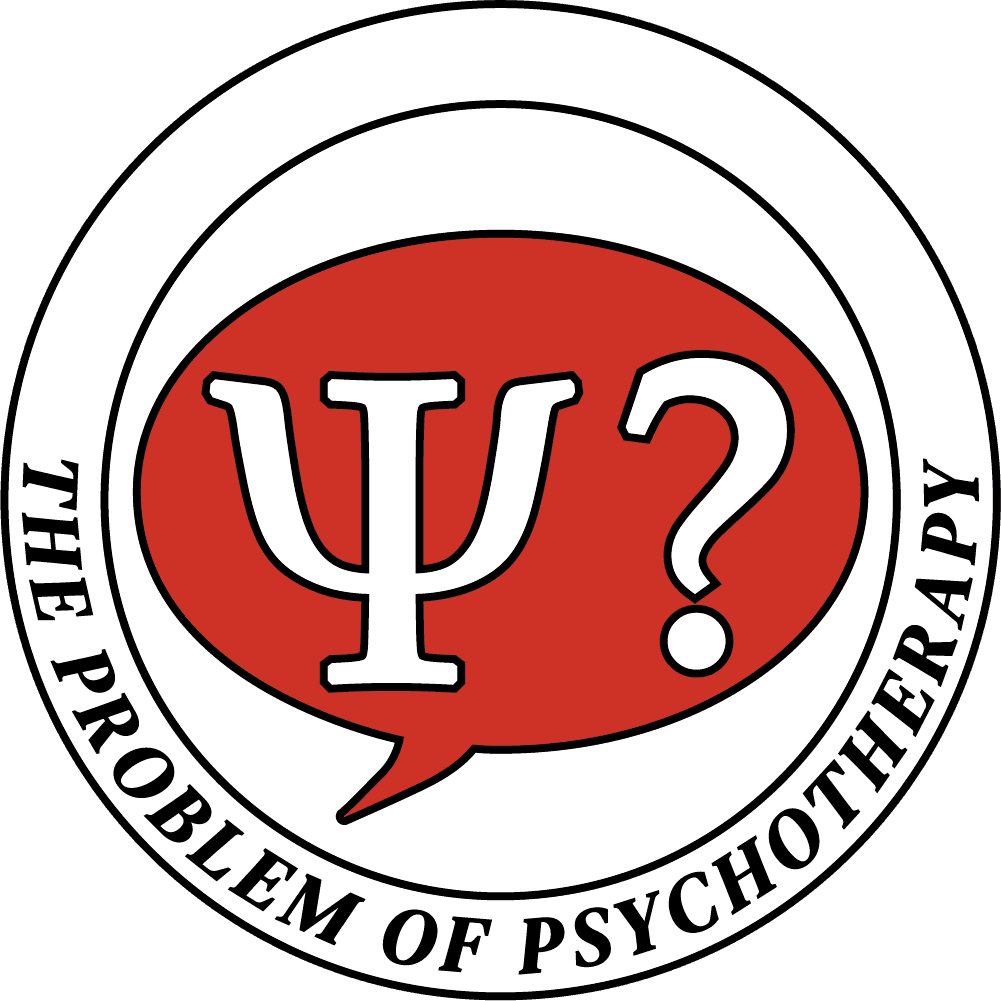
Problem of Psychotherapy
Refers to how psychotherapists bridge research and theory in a way that assimilates and integrates the key insights from the major perspectives to develop the most comprehensive and effective systems for fostering psychological well-being. This problem is evident in the complete lack of any coherent, holistic paradigm in psychotherapy.
Refers to how psychotherapists bridge research and theory in a way that assimilates and integrates the key insights from the major perspectives to develop the most comprehensive and effective systems for fostering psychological well-being. This problem is evident in the complete lack of any coherent, holistic paradigm in psychotherapy.
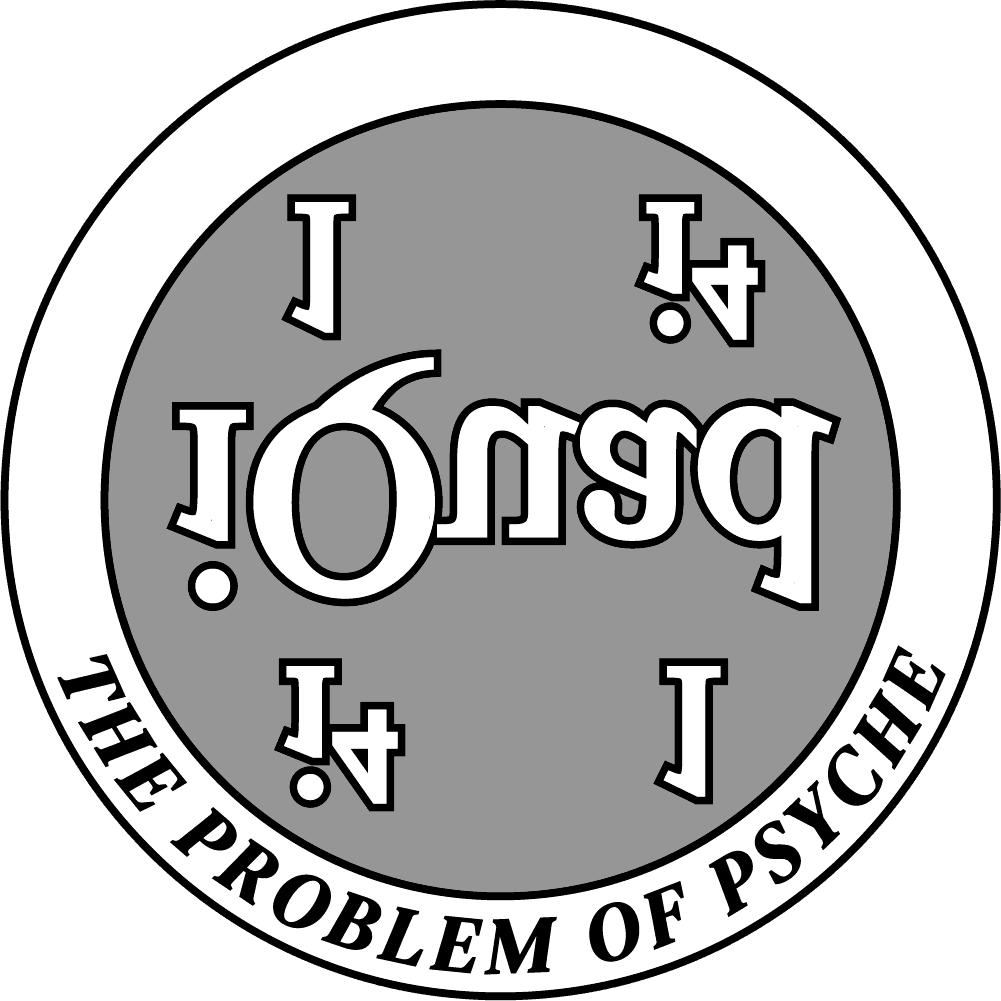
Problem of the Psyche
Refers to the problem of both subjective conscious experience (i.e., the hard problem of consciousness) and the problem of specifying the nature of subjective knowledge relative to intersubjective and scientific knowledge. The psyche is a humanistic construct rather than a scientific one.
Refers to the problem of both subjective conscious experience (i.e., the hard problem of consciousness) and the problem of specifying the nature of subjective knowledge relative to intersubjective and scientific knowledge. The psyche is a humanistic construct rather than a scientific one.
The Three Philosophical Pillars
The Three Philosophical Pillars
With its three philosophical pillars, UTOK provides explicit frameworks for bridging the knowledge of the natural sciences, the perspective of a particular human subject, and an archetypal paradigm for cultural collectives to orient toward wise living.
With its three philosophical pillars, UTOK provides explicit frameworks for bridging the knowledge of the natural sciences, the perspective of a particular human subject, and an archetypal paradigm for cultural collectives to orient toward wise living.

The Tree of Knowledge System
provides a new map of reality and how science maps it. It provides UTOK’s lens for objective behavior patterns in nature. The ToK System divides the natural world into four planes of existence (i.e., material objects, living organisms, minded animals, and cultured persons), and allows UTOK to solve the problem of psychology by clearly specifying the Mind-Animal plane of existence.
provides a new map of reality and how science maps it. It provides UTOK’s lens for objective behavior patterns in nature. The ToK System divides the natural world into four planes of existence (i.e., material objects, living organisms, minded animals, and cultured persons), and allows UTOK to solve the problem of psychology by clearly specifying the Mind-Animal plane of existence.

The iQuad Coin
provides a way to frame the human psyche as the human identity functional matrix. As such, it provides UTOK’s lens for the subjective, phenomenological perspective. The architecture of the iQuad Coin aligns the human identity matrix with the complex unit circle in math. The result is that it allows the subjective psyche to be bridged into mathematics, physics, and philosophy.
provides a way to frame the human psyche as the human identity functional matrix. As such, it provides UTOK’s lens for the subjective, phenomenological perspective. The architecture of the iQuad Coin aligns the human identity matrix with the complex unit circle in math. The result is that it allows the subjective psyche to be bridged into mathematics, physics, and philosophy.
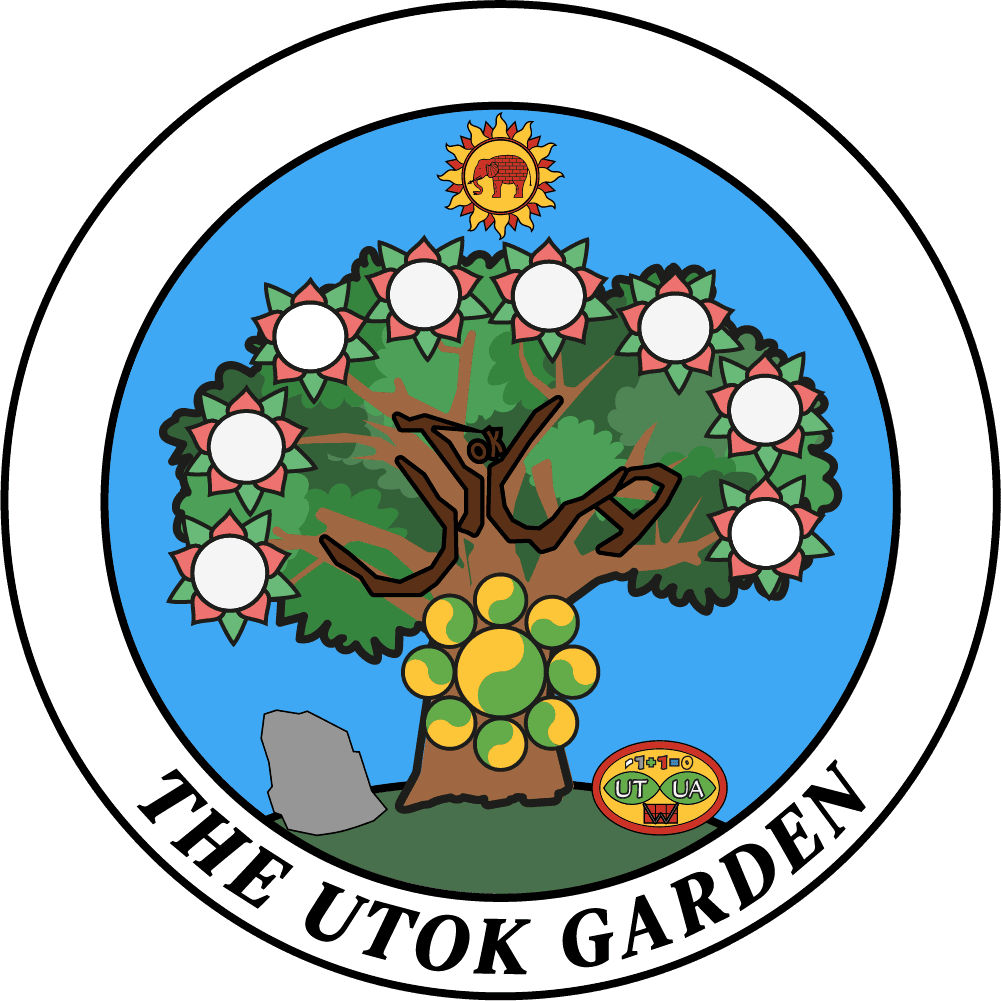
The UTOK Garden
provides the frame for the intersubjective, social construction of knowledge and is an archetype for collective wisdom. The Garden represents the large-scale system of justification that allows us to generate a shared narrative for clarifying what is and cultivating what ought to be.
provides the frame for the intersubjective, social construction of knowledge and is an archetype for collective wisdom. The Garden represents the large-scale system of justification that allows us to generate a shared narrative for clarifying what is and cultivating what ought to be.
UTOK’s core mantra, Marry the Coin to the Tree in the Garden under God, frames how we can interweave these three philosophical pillars together.
UTOK’s core mantra, Marry the Coin to the Tree in the Garden under God, frames how we can interweave these three philosophical pillars together.
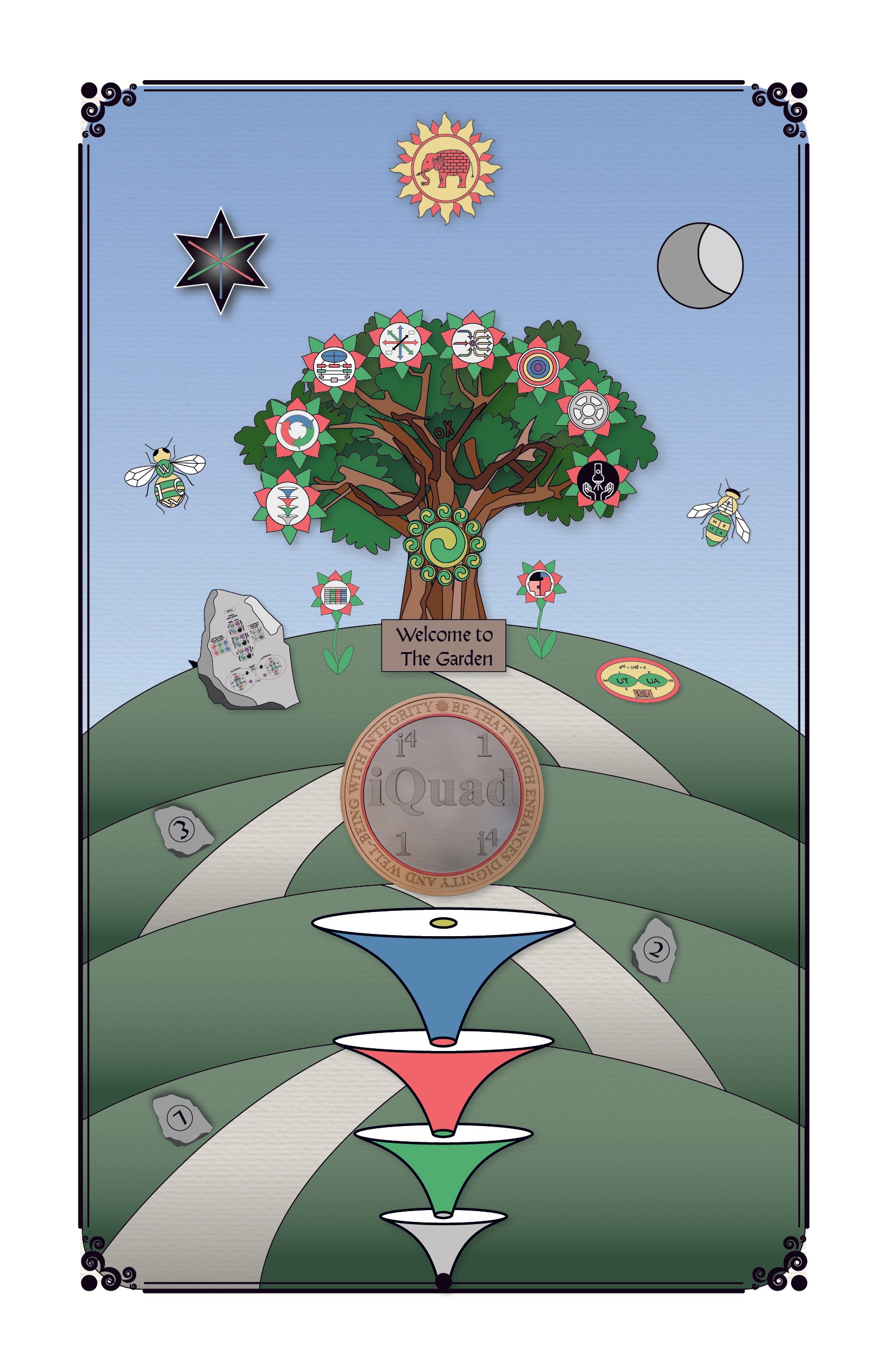


This depiction is from book UTOK: The Unified Theory of Knowledge.
To follow it, start with the iQuad Coin, which creates a portal to the individual. Around the iQuad Coin is UTOK’s ultimate justification, which is Be that which enhances dignity and well-being with integrity. This invites an alignment between the subject and the UTOK system regarding core values. Beneath the iQuad Coin is the Tree of Knowledge System. You “marry the Coin to the Tree” by rotating your perspective and seeing your self as a cultured person who is also a minded animal and a living organism and a material object on a grid of space and time in a larger energy-information field. There is then the iQuad Path to the Garden, which is the “seed” of wise living. Thus, one is oriented toward cultivating valued states of being. Above the Garden is the Elephant Sun God, which is UTOK’s symbol of the transcendent, or of wisdom energy, or of loving goodness, truth and beauty.
This depiction is from book UTOK: The Unified Theory of Knowledge.
To follow it, start with the iQuad Coin, which creates a portal to the individual. Around the iQuad Coin is UTOK’s ultimate justification, which is Be that which enhances dignity and well-being with integrity. This invites an alignment between the subject and the UTOK system regarding core values. Beneath the iQuad Coin is the Tree of Knowledge System. You “marry the Coin to the Tree” by rotating your perspective and seeing your self as a cultured person who is also a minded animal and a living organism and a material object on a grid of space and time in a larger energy-information field. There is then the iQuad Path to the Garden, which is the “seed” of wise living. Thus, one is oriented toward cultivating valued states of being. Above the Garden is the Elephant Sun God, which is UTOK’s symbol of the transcendent, or of wisdom energy, or of loving goodness, truth and beauty.
UTOK’s core mantra, Marry the Coin to the Tree in the Garden under God, frames how we can interweave these three philosophical pillars together.
UTOK’s Metapsychology:
UTOK’s Metapsychology:
Unifying the science of psychology with the practice of psychotherapy
Unifying the science of psychology with the
practice of psychotherapy
Unifying the science of psychology with the practice of psychotherapy
The Unified Theory of Psychology (UT)
The Unified Theory of Psychology (UT)
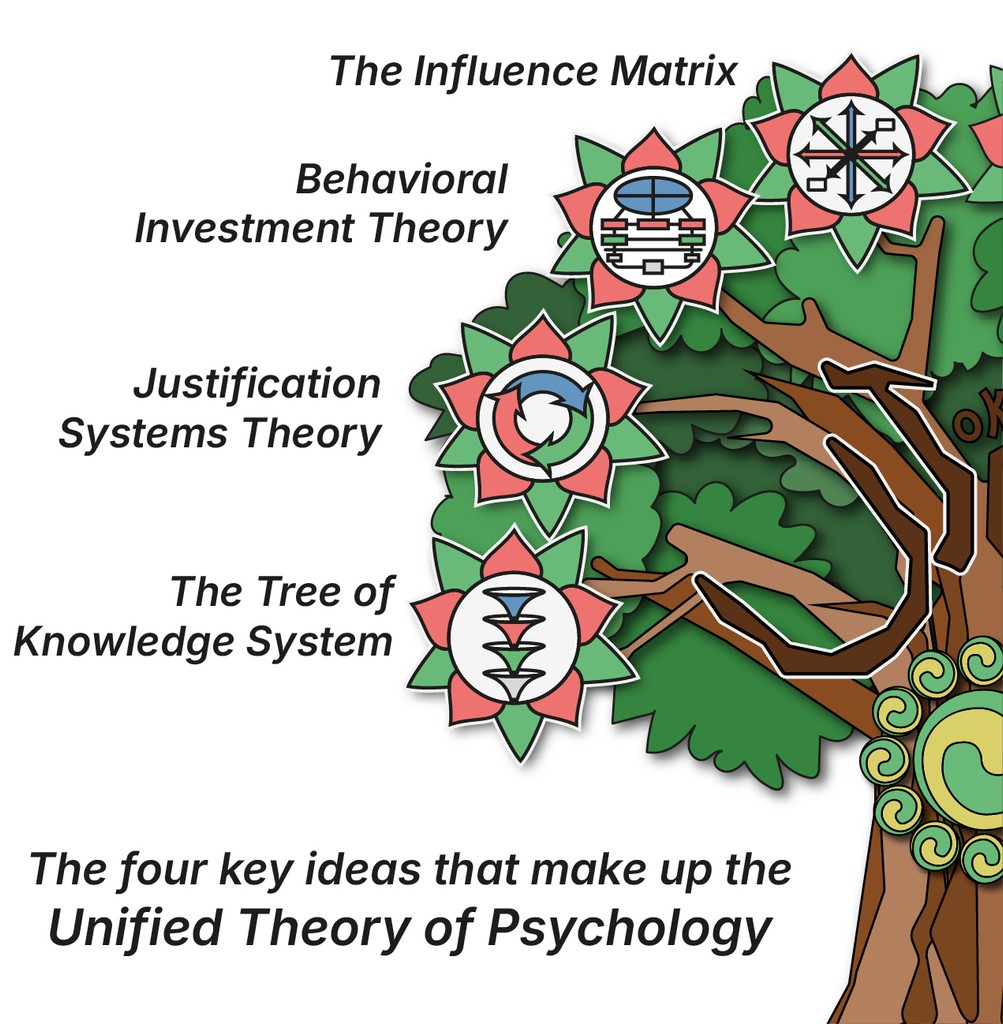

Professor Henriques initially framed UTOK initially was framed as a unified theory of psychology (UT), which was detailed in his first book in 2011, A New Unified Theory of Psychology (LINK TO BOOK PAGE). It shows how the Tree of Knowledge System provides the needed big picture view to solve the problem of psychology by showing how the Mind-Animal plane existed above the Life-Organism plane and below the Culture-Person plane. In addition, the book explained how Justification Systems Theory frames human consciousness, Behavioral Investment Theory frames animal behavior and cognition, and the Influence Matrix frames the human relationship system. Together they provide the necessary metatheoretical architecture for assimilating and integrated key concepts, theories, and empirical findings into a coherent, holistic conception of the field. The book also shows how UTOK defines psychology by delineating its three great branches: 1) basic psychology (i.e., science of mind, brain and behavior); 2) human psychology (i.e., mental behaviors of human individuals and small groups); and 3) professional psychology (i.e., the application of such knowledge toward improving human well-being).
Professor Henriques initially framed UTOK initially was framed as a unified theory of psychology (UT), which was detailed in his first book in 2011, A New Unified Theory of Psychology (LINK TO BOOK PAGE). It shows how the Tree of Knowledge System provides the needed big picture view to solve the problem of psychology by showing how the Mind-Animal plane existed above the Life-Organism plane and below the Culture-Person plane. In addition, the book explained how Justification Systems Theory frames human consciousness, Behavioral Investment Theory frames animal behavior and cognition, and the Influence Matrix frames the human relationship system. Together they provide the necessary metatheoretical architecture for assimilating and integrated key concepts, theories, and empirical findings into a coherent, holistic conception of the field. The book also shows how UTOK defines psychology by delineating its three great branches: 1) basic psychology (i.e., science of mind, brain and behavior); 2) human psychology (i.e., mental behaviors of human individuals and small groups); and 3) professional psychology (i.e., the application of such knowledge toward improving human well-being).
The Unified Approach to Psychotherapy (UA)
The Unified Approach to Psychotherapy (UA)
UTOK starts in the therapy room, with the question, what should be the scientific framework that guides psychological practitioners? With that question answered via the Unified Theory of Psychology (UT), the Unified Approach to Psychotherapy (UA) turns to the process of psychotherapy to develop a common core. It also consists of four key ideas. Character Adaptation Systems Theory connects the major schools of individual psychotherapy to different systems of adaptation, the Wheel of Development identifies the major domains of individual difference, the Nested Model maps human well-being, and CALM-MO provides an integrative approach to psychological mindfulness that reverses neurotic loops via cultivating a Metacognitive Observing stance that is curious, accepting, loving and compassionate, and motivated toward valued states of being. A recent paper on the UA shows how it can explain major findings in psychotherapy and provide a “common core” that defines the center of the discipline.
UTOK starts in the therapy room, with the question, what should be the scientific framework that guides psychological practitioners? With that question answered via the Unified Theory of Psychology (UT), the Unified Approach to Psychotherapy (UA) turns to the process of psychotherapy to develop a common core. It also consists of four key ideas. Character Adaptation Systems Theory connects the major schools of individual psychotherapy to different systems of adaptation, the Wheel of Development identifies the major domains of individual difference, the Nested Model maps human well-being, and CALM-MO provides an integrative approach to psychological mindfulness that reverses neurotic loops via cultivating a Metacognitive Observing stance that is curious, accepting, loving and compassionate, and motivated toward valued states of being. A recent paper on the UA shows how it can explain major findings in psychotherapy and provide a “common core” that defines the center of the discipline.
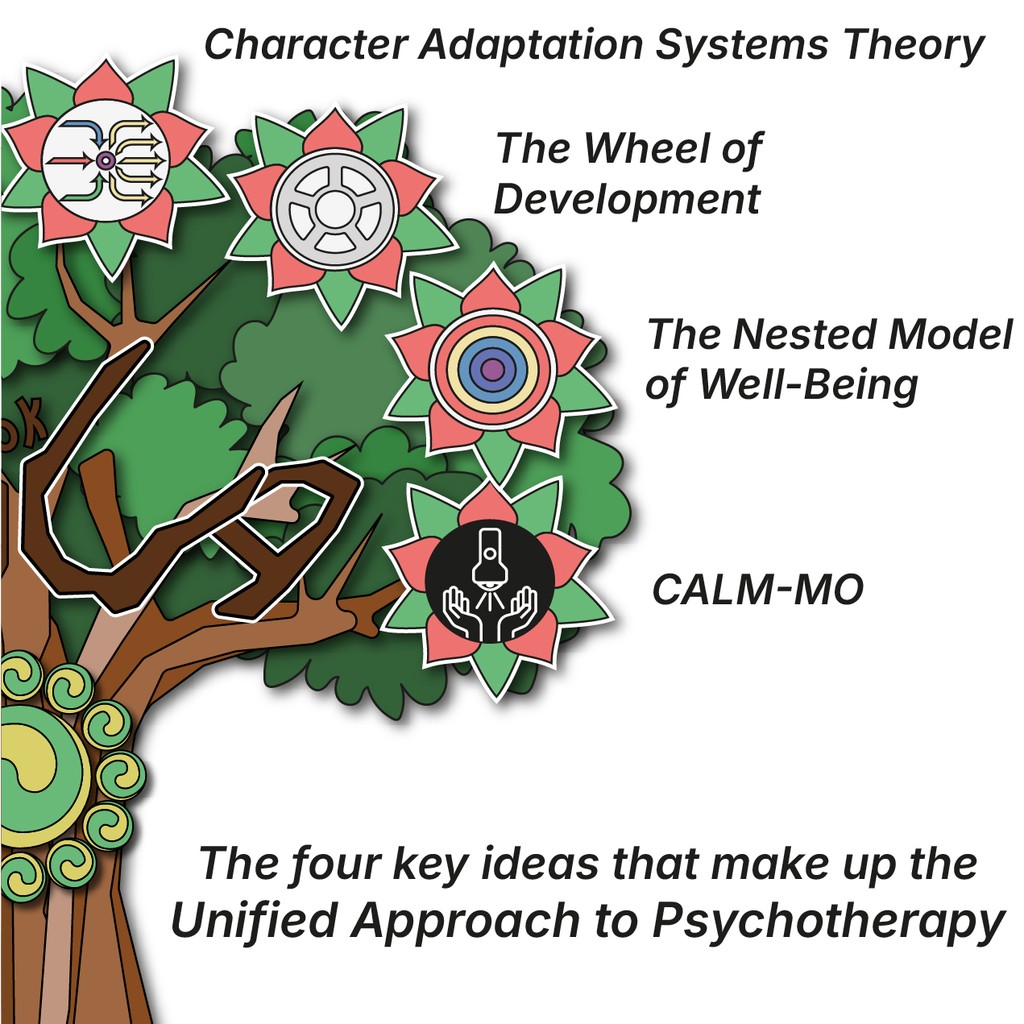

The UTOK 20
The UTOK 20
UTOK is a network of ideas that bridges theories and archetypes into a new scientific humanistic philosophy that resolves the mind-body problem. The UTOK-20 provides a way to depict each key idea that is part of the system. It starts with the four problems, arrives that the iQuad Coin, which represents both the problem of the psyche and the human knower, and then identifies the 19 other ideas that made up the whole. See here for a quick summary of the ideas placed on the UTOK Christmas Tree of Knowledge.
UTOK is a network of ideas that bridges theories and archetypes into a new scientific humanistic philosophy that resolves the mind-body problem. The UTOK-20 provides a way to depict each key idea that is part of the system. It starts with the four problems, arrives that the iQuad Coin, which represents both the problem of the psyche and the human knower, and then identifies the 19 other ideas that made up the whole. See here for a quick summary of the ideas placed on the UTOK Christmas Tree of Knowledge.
